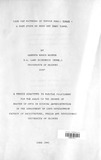| dc.description.abstract | Urbanization in Kenya has been associated with
numerous problems such as mass migrations from rural
areas to urban areas, lack of proper housing for ever
increasing urban population, unemployment, lack of
social facilities and pollution. While all the above
problems have been given much attention, little attention
has been given to the pattern of ensuing land use in
these urban areas. This study therefore set out to
examine the land use patterns in two small but rapidly
growing towns of Embu and Meru in the Eastern Province
of Kenya. Land use patterns in these two towns could not be
legitimately defined according to systematic zones
because they were characterized by too many cases of land
use conflicts. Land uses looked haphazard, especially
in the outskirts of the town centres. For instance, the
Central Business Districts of the two towns were
characterized by mixtures of different land uses, such
as commercial versus residential, and commercial versus
industrial. In Embu town there was an Asian residential
estate at the centre of Central Business area.
In Meru the same problem was inherent. In the Central
Business area·of Meru was a milk processing plant.
Similarly, industries in Meru town were growing in the
midst of residential areas. The above observations contradicted
the generalized neo-classical models of
urban land use patterns; meaning that land use patterns
in these towns could not be further explained by these
celebrated neo-classical theories.
In conducting the study, first a personal
observation survey was carried out in the two towns to .
examine the existing land uses and appreciate the
settlement patterns. Furthermore, four sets of
questionnaires were administered, three to plot/land
owners of different kinds of land uses and the other to
the planning authorities. These helped in coming up
with the factors that caused the existing land use
patterns in the towns.
From the study, it was found that a coherent and
consistent land use pattern could not be defined in
these towns. The land use patterns in these two towns
could not be defin~d as resembling any land use patterns
explained by the neo-cla~sical theories, but light
imprints of some of the theories were traceable.
Existing land use patterns in both towns were
found to be a consequence of many factors which included.
economic, social values, government intervention and
policy, political pressure, poor development control,
- scarcity of public land and private land ownership. | en_US |

